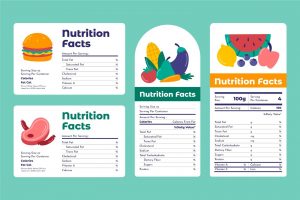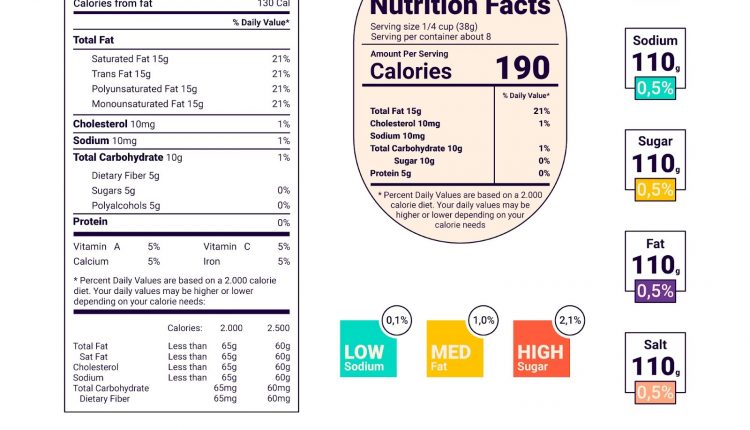Decoding Food Labels for Better Health
Master the Art of Reading Nutrition Labels for Smarter, Healthier Choices
Ever stood in the grocery aisle, squinting at those tiny numbers and unfamiliar terms on food labels, wondering what in the world they mean? You’re not alone. Nutrition labels can be confusing, but understanding them is crucial for making healthier choices. Let’s unravel the mysteries of these labels together and turn your next shopping trip into a savvy, health-conscious experience.
Serving Size: Your Starting Point
Serving size is the foundation of understanding nutrition labels. It tells you how much of the product the nutritional information refers to. This can be a bit misleading because most of us don’t eat just one serving. For instance, if a bag of chips lists a serving size as 1 ounce but the bag contains 8 ounces, you might end up consuming 8 servings in one sitting. Always check this to gauge how much you’re really consuming.
When looking at serving sizes, consider how they match up with your portion sizes at home. If the serving size is too small to match your usual portion, adjust the calories and nutrients accordingly. For instance, if you typically eat two servings of cereal for breakfast, double the calories and nutrients listed to get an accurate picture.
Calories: The Energy Count
Calories are a measure of energy. They indicate how much energy you’ll get from eating a particular amount of the food. But not all calories are created equal. It’s not just about the total number but where those calories come from.

Whole foods, like fruits, vegetables, and lean proteins, provide more nutrients per calorie than processed foods. For instance, a serving of almonds might be around 150 calories but provides healthy fats, protein, and essential nutrients. In contrast, a 150-calorie serving of candy provides sugar and empty calories with little nutritional benefit.
Pay attention to how many calories you need based on your lifestyle. Sedentary people need fewer calories compared to those who are very active. Adjust your calorie intake based on your daily activity levels to maintain a balanced diet.
Fats: Understanding the Good, the Bad, and the Ugly
Fats are an essential part of a healthy diet, but it’s important to understand the different types and their effects on health.
- Total Fat: This includes all types of fats in the product. It’s important to monitor your total fat intake but also to look deeper.
- Saturated Fat: High levels of saturated fat can raise cholesterol levels and increase the risk of heart disease. Aim for products low in saturated fat, and opt for healthier fats like those from avocados, nuts, and olive oil.
- Trans Fat: This type of fat is often found in processed foods and can be harmful. Trans fats raise bad cholesterol levels while lowering good cholesterol levels, which is why it’s best to avoid them altogether.
Carbohydrates: The Energy Source
Carbohydrates are a primary source of energy, but they come in different forms:
- Total Carbohydrates: This figure includes all carbs in the food. It’s important to distinguish between types of carbohydrates to make healthy choices.
- Dietary Fiber: Fiber is beneficial for digestive health and helps you feel full. Foods high in fiber, such as whole grains, fruits, and vegetables, are great choices.
- Sugars: Both natural and added sugars are listed. Added sugars are the ones to watch out for, as they contribute to empty calories and can lead to weight gain and other health issues. Opt for foods with minimal added sugars and check for terms like “high fructose corn syrup” or “sucrose” on the ingredient list.
Proteins: Building Blocks of Health
Protein is essential for muscle repair, growth, and overall bodily functions.
- Protein Content: Look for foods that provide a good source of protein, especially if you are active or trying to build muscle. Lean meats, beans, nuts, and dairy products are excellent sources.
Not all proteins are equal. Animal proteins often come with saturated fats, so it’s beneficial to balance these with plant-based proteins. Beans, lentils, tofu, and nuts are great alternatives that provide protein without the added fats.
Vitamins and Minerals: Micronutrients Matter
Vitamins and minerals are crucial for overall health but are often present in small quantities.
- Daily Values (DVs): These percentages indicate how much a nutrient in a serving contributes to your daily needs. They’re based on a 2,000-calorie diet, which may not fit everyone’s needs. Adjust according to your own dietary requirements.
- Vitamins: Look for key vitamins like A, C, D, E, and the B vitamins. They support various bodily functions, including immune system health and energy metabolism.
- Minerals: Important minerals include calcium, iron, and potassium. Calcium supports bone health, iron is vital for blood production, and potassium helps maintain blood pressure levels.
Ingredients List: The Real Story
The ingredients list reveals the actual components of the food. Ingredients are listed in descending order of weight, so the first few items are the most prevalent in the product.
- Whole Ingredients: Aim for foods with whole, recognizable ingredients like fruits, vegetables, and whole grains. The fewer processed ingredients, the better.
- Hidden Sugars and Additives: Watch out for hidden sugars and additives. Ingredients like “high fructose corn syrup” or “maltodextrin” are red flags for processed products.
- Allergens: If you have allergies or intolerances, make sure to check for any potential allergens listed, such as peanuts, gluten, or dairy.

Misleading Terms: What to Watch For
Food labels often feature terms that can be misleading.
- Organic: This means the food is produced without synthetic pesticides or fertilizers. While organic foods are often more environmentally friendly, they’re not necessarily healthier.
- Natural: There’s no official definition for “natural,” so it’s often used as a marketing term. Always check the ingredient list for a clearer idea of what’s in the product.
- Low-Fat: Products labeled as “low-fat” can still be high in sugars or other additives. It’s crucial to look at the full nutrition profile, not just the fat content.
Understanding Daily Values: A Percent Perspective
Daily values (DVs) show how a nutrient in a serving of food contributes to your daily diet. These percentages are based on a standard 2,000-calorie diet, which is a general guideline and might not suit everyone’s needs.
Use DVs as a guide for understanding if a food item is high or low in certain nutrients. For example, if a product has 25% of the daily value for sodium, it means it provides a quarter of the recommended daily intake.
Latest Trends in Food Labeling
Food labeling is becoming more transparent. Recent trends include:
- Added Sugars: More labels now include added sugars, making it easier to see how much sugar has been added during processing.
- Nutrient Highlights: New label formats highlight key nutrients, making it easier to quickly assess a product’s nutritional value.
- Clearer Fonts and Graphics: Improved label designs use larger fonts and clearer graphics to make nutritional information more accessible.
Deciphering Health Claims
Health claims on packaging can be persuasive but often require scrutiny. Terms like “heart-healthy,” “low-carb,” or “boosts immunity” can be enticing. However, they might not always reflect the full picture. For example, a product claiming to be “low-carb” might still contain unhealthy fats or additives. Always cross-reference these claims with the actual nutrition facts and ingredient list.
Portion Control and Moderation
Even with a clear understanding of nutrition labels, portion control remains vital. A healthy food can still contribute to weight gain if consumed in excessive amounts. Practice moderation and aim to balance your diet with a variety of nutrient-rich foods. Think of labels as a tool for making informed choices rather than a sole determinant of whether a food is healthy.
Balancing Nutritional Goals with Lifestyle
Everyone’s nutritional needs vary based on factors such as age, gender, activity level, and health goals. Use food labels to align your diet with your personal health objectives. If you’re aiming to build muscle, prioritize protein-rich foods. If you’re focusing on heart health, look for foods low in saturated fats and high in fiber.
Making Informed Choices
Understanding nutrition labels empowers you to make informed choices, not just at the grocery store but also when dining out or preparing meals. Use your knowledge to select foods that align with your health goals, whether it’s reducing sodium intake, increasing fiber, or avoiding certain allergens.
The Future of Food Labels
As awareness around health and nutrition grows, food labels will continue to evolve. Future labels may include even more detailed information about the environmental impact of food production or more personalized nutritional advice. Staying informed about these changes can help you adapt and make the best choices for your health.
By getting familiar with how to read and interpret food labels, you’re making a significant step toward better health. It’s about making informed choices and understanding what’s truly in your food. So next time you’re at the store, let your newfound knowledge guide you. Happy shopping and here’s to making healthier choices every day!

